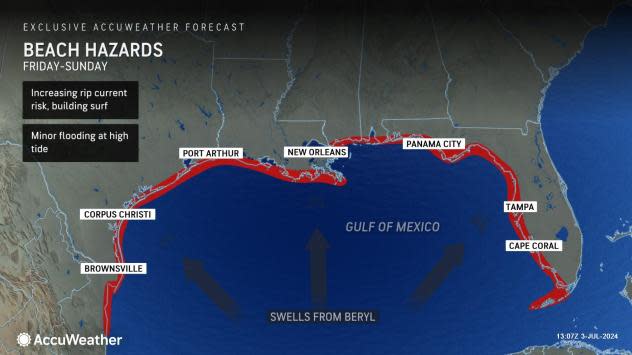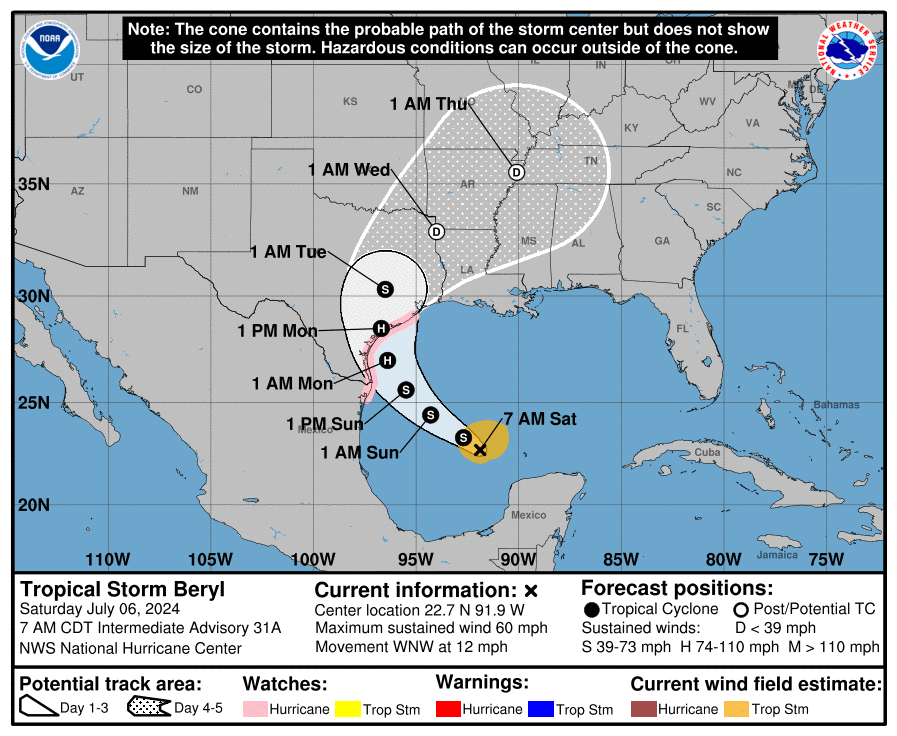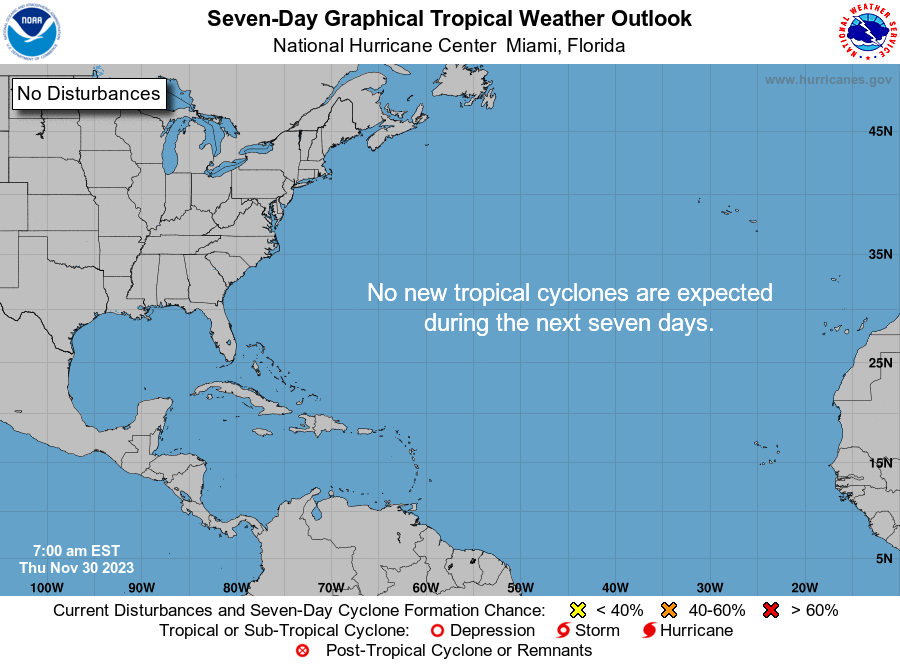Beryl expected to be hurricane near landfall in Texas, swells may cause rip currents
Days after landfall, the National Hurricane Center continued issuing advisories on Tropical Storm Beryl, located over the southern Gulf of Mexico. A hurricane hunter aircraft was investigating Beryl, which is expected to be a hurricane near landfall in Texas.
Other than Beryl, as of 8 a.m. Saturday, July 6, tropical cyclone formation was not expected during the next 7 days.
Here's the latest update from the NHC as of 8 a.m. Saturday, July 6:
Spaghetti models: Where will Hurricane Beryl go next?
Special note about spaghetti models: Illustrations include an array of forecast tools and models, and not all are created equal. The Hurricane Center uses only the top four or five highest performing models to help make its forecasts.
How could Hurricane Beryl affect Florida?

Large swells generated by Beryl are expected to reach much of the Gulf Coast of the U.S. — including all of Florida's West Coast and Panhandle. The swells are expected to cause life-threatening surf and rip current conditions.
Watches, warnings issued across Florida
Hurricane Beryl: What you need to know

Location: 495 miles southeast of Corpus Christi, Texas
Maximum sustained winds: 60 mph
Movement: west-northwest at 12 mph
Watches and warnings issued for Hurricane Beryl
Hurricane watch: A hurricane watch is in effect for the following:
The Texas coast from the mouth of the Rio Grande northward to San Luis Pass
The northeastern coast of mainland Mexico from Barra el Mezquital to the mouth of the Rio Grande
A hurricane watch means that hurricane conditions are possible within the watch area. A watch is typically issued 48 hours before the anticipated first occurrence of tropical-storm-force winds, conditions that make outside preparations difficult or dangerous.
Storm surge watch: A storm surge watch is in effect for the following:
The Texas coast from the mouth of the Rio Grande northward to High Island
A storm surge watch means there is a possibility of life-threatening inundation, from rising water moving inland from the coastline, in the indicated locations during the next 48 hours.
Hurricane Beryl: Here's latest information on strength, forecast path
At 8 a.m. EDT, the center of Tropical Storm Beryl was located near 495 miles southeast of Corpus Christi, Texas. Maximum sustained winds were near 60 mph. Beryl was moving west-northwest at 12 mph.
A turn to the northwest is expected later today and then north-northwestward by Sunday night. On the forecast track, the center of Beryl is expected to approach the Texas coast by late Sunday into Monday morning.
Reports from NOAA and Air Force Reserve Hurricane Hunter aircraft indicate that maximum sustained winds are near 60 mph with higher gusts. Little change in strength is expected today, but strengthening is expected to begin by Sunday, and Beryl is forecast to become a hurricane before it reaches the Texas coast.
Tropical-storm-force winds extend outward up to 105 miles from the center.
How strong is Hurricane Beryl and where is it going?
Key messages from the National Hurricane Center: What you need to know about Hurricane Beryl
There is an increasing risk of damaging hurricane-force winds and life-threatening storm surge in portions of northeastern Mexico and the lower and middle Texas coast late Sunday into Monday where hurricane and storm surge watches have been issued. Additional watches may be required today. Interests in these areas should follow any advice given by local officials.
Flash and urban flooding are possible across portions of the Texas Gulf Coast and eastern Texas from Sunday through the middle of next week.
Rip currents will cause life-threatening beach conditions through the weekend across much of the Gulf Coast. Beachgoers should heed warning flags and the advice of lifeguards and local officials before venturing into the water.
What impact could Hurricane Beryl have and what areas could be affected?
What is storm surge? Graphics explain the deadly weather event
Wind: Hurricane conditions are possible in the hurricane watch area along the Gulf coast of northeastern Mexico and Texas by early Monday, with tropical storm conditions beginning Sunday night.
Storm surge: The combination of storm surge and tide will cause normally dry areas near the coast to be flooded by rising waters moving inland from the shoreline. The water could reach the following heights above ground somewhere in the indicated areas if the peak surge occurs at the time of high tide.
Baffin Bay, Texas, to San Luis Pass, Texas: 3 to 5 feet
Corpus Christi Bay: 3 to 5 feet
Matagorda Bay: 3 to 5 feet
Mouth of the Rio Grande, Texas, to Baffin Bay, Texas: 2 to 4 feet
San Luis Pass, Texas, to High Island, Texas: 2 to 4 feet
Galveston Bay: 2 to 4 feet
The deepest water will occur along the immediate coast near and to the right of the center, where the surge will be accompanied by large and destructive waves. Surge-related flooding depends on the relative timing of the surge and the tidal cycle, and can vary greatly over short distances.
Rainfall: Heavy rainfall of 5 to 10 inches with localized amounts of 15 inches is expected across portions of the Texas Gulf Coast and eastern Texas beginning late Sunday through midweek. This rainfall is likely to produce areas of flash and urban flooding, some of which may be locally considerable in nature.
Surf: Large swells generated by Beryl are currently impacting portions of the coast of the Yucatan Peninsula. The swells are expected to reach eastern Mexico and much of the Gulf Coast of the U.S. shortly. These swells are expected to cause life-threatening surf and rip current conditions.
When is the Atlantic hurricane season?
The Atlantic hurricane season runs from June 1 through Nov. 30.
When is the peak of hurricane season?

The peak of the season is Sept. 10, with the most activity happening between mid-August and mid-October, according to the Hurricane Center.
National Hurricane Center map: What are forecasters watching now?
Systems currently being monitored by the National Hurricane Center include:

Interactive map: Hurricanes, tropical storms that have passed near your city
Excessive rainfall forecast
What's next?
We will continue to update our tropical weather coverage daily. Download your local site's app to ensure you're always connected to the news. And look for our special subscription offers here.
This article originally appeared on Florida Today: Where is Hurricane Beryl: track forecast, path before Texas landfall

